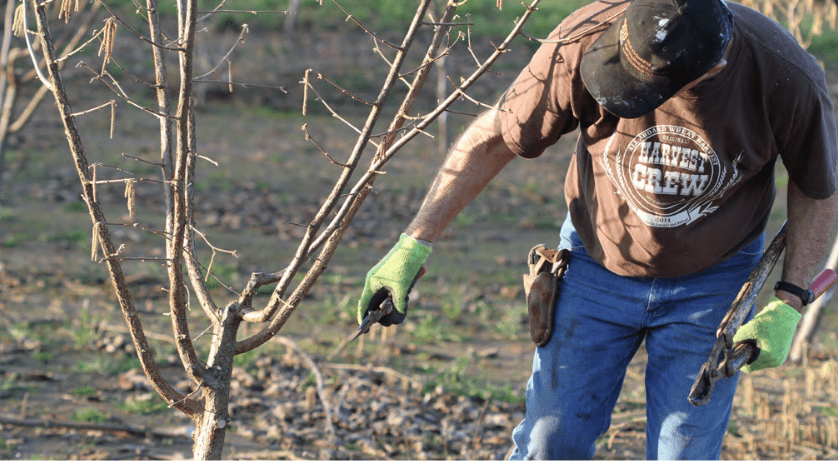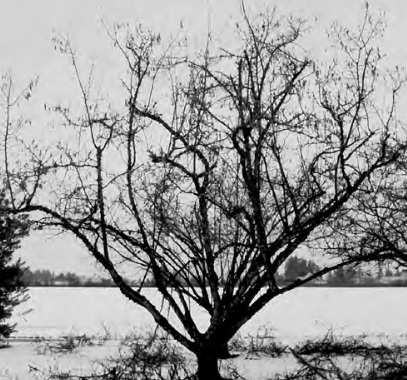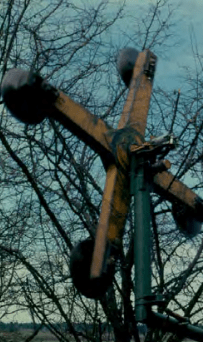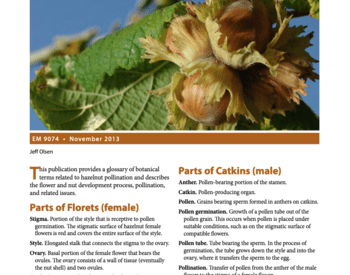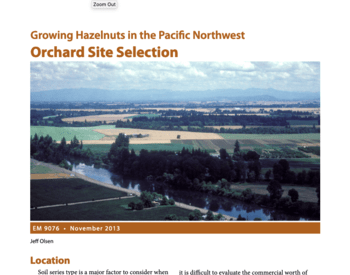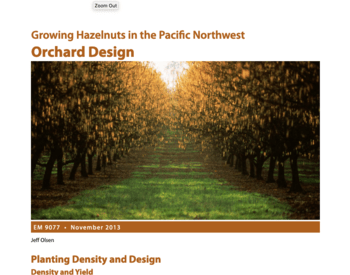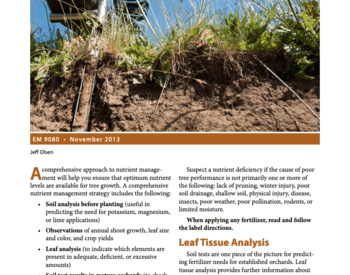Training Young Trees
Training and pruning young trees in the first and second years after planting is much different from pruning mature orchards. The main objective when training trees is to develop a strong system of major scaffold limbs to form the tree’s framework.
During the first dormant season, select three to five major limbs to become the scaffold branches. Choose limbs that are evenly spaced around the tree trunk in different directions and have some vertical space between them (preferably at least 6 inches, or 15.2 cm). Remove all of the other limbs.
If the primary scaffolds have grown more than 2 feet in length and failed to send out lateral shoots, head them to stimulate lateral branches. If you don’t find the primary scaffolds in the first dormant season, be patient and find the right ones in the second dormant season.
Very little pruning is necessary after the scaffold structure has been established. Heavy pruning of young trees can be detrimental because it can prolong the nonbearing period by promoting excessive shoot growth. Pruning can also cause suckers to develop from wounds, and this growth can crowd the center of the tree and shade other limbs. For some newer varieties, you may need to prune to regulate the amount of nuts on young trees so the trees don’t become stunted from overcropping.
Pruning Mature Orchards
When to Prune
Tree condition is the best indicator of the need for pruning. It is time to prune when any of the following conditions exist:
• A reasonable fertilizer and soil management program fails to produce an average of 6 inches (15.2 cm) or more of annual terminal growth.
• There are numerous dead twigs in the center and lower parts of trees due to excessive shading.
• The outside rows of trees in the orchard show significantly more vigor and better foliage color than the inner tree rows, again due to excessive shading.
The Oregon State University recommendation for production pruning is to prune mature hazelnuts on a 5-year rotation—one-fifth of the orchard each year. Regular pruning increases yield, helps reinvigorate the pruned trees for years to come (Figure 1), and is also a way to avoid biennial bearing (higher and lower yields in alternating years).
Experiments have shown that hazelnut yields are reduced the first year after heavy pruning but increase substantially in the second and later years. This is another reason to prune only a portion of the orchard each year. Also, cutting 50% of the bearing surface from 20% of the trees takes considerably less time than removing 5%–8% of the bearing surface from all trees each year.
What to Prune
Remove about half of the fruiting wood on each tree pruned. Catkins are a good indication of where the fruiting wood is in a tree. Remove as much of the poorly growing, moss-covered wood as possible, but leave large scaffold branches on which to grow new fruiting wood.
Trim out the center branches, and shorten the low laterals. This makes it easier to move equipment in the orchard. Remove suckers that grow up through the canopy from lower limbs, unless you can use these suckers to fill an opening in the top of the tree. In general, thin the tree so that sunlight penetrates to all parts of the tree.
Types of Pruning
Pruning can be simple. There are only two types of pruning cuts:
• Heading removes a portion of a branch. Heading cuts to large-diameter branches tend to cause a flush of vigorous shoot growth below the cut. This regrown often is not productive for a few years. Too many heading cuts can actually cause less light to get into the tree because they have a sort of blanketing effect on the outside of the tree.
• Thinning removes the whole branch. Thinning cuts tend to open the tree up to sunlight penetration, which is necessary for nut set. Most pruning cuts on mature trees should be thinning cuts. Make the cut to a lateral branch. This helps channel the regrowth and allows you to make a healthy pruning cut.
Healthy Pruning Cuts
A healthy pruning cut leaves the branch collar intact and does not leave a stub. The branch collar is the raised area at the base of every branch. It contains specialized cells that seal off a pruning wound. This helps prevent wood rot fungus from infecting the branch through the pruning wound.
There is no conclusive evidence that dressing wounds after pruning helps prevent wood rot. To reduce the danger of wood rot after pruning, cut small wood high in the tree rather than large branches, and cut to the branch collar but not through it (Figure 2).
Pruning to Reduce Height
Many mature hazelnut orchards need to be reduced in height. Overgrown orchards present several challenges. It is difficult to achieve thorough spray coverage at the tops of the trees. Too-tall trees also shade out much of the sides of the trees, so the crop is restricted to the very tops of the trees. All of the nuts are produced on the top third of the tree, and the other two thirds are just support scaffolding. This is not a very efficient tree form. The middle third of the tree should also be productive. In older orchards, the bottom third will always be just support wood.
Choose a level that you want to bring the tree down to. In most overgrown orchards, you will be cutting off about 10–15 feet in height. Allow for a range of height because you are not going to give the tree a “flattop”. Remember: You are going to cut to lateral branches that are within the height range—they are not likely to be all at the same height.
Your goal in a rotational pruning program is to remove half of the fruiting wood on the trees you prune. By starting with height reduction cuts, you are likely to be very near your goal after making them.
Mechanical Hedging
Some growers use mechanical hedging with gang saws to renovate an overgrown orchard (Figure 3).This is a rapid, economical way to remove large amounts of wood. Yields have increased in some older orchards after hedging. Regrowth often is so rapid that the space between trees created by hedging is filled in after two seasons.
ne disadvantage of mechanical hedging is that the cuts are made indiscriminately in a straight plane, often resulting in a lot of dead branches lower in the tree. Also, all new growth is concentrated along the plane of cutting. Growth in other parts of the tree might be reduced unless you do some follow-up hand pruning.
Orchards with eastern filbert blight cankers will require more detailed hand pruning to remove all of the infected tissue. Prune back at least 1 foot past the last visible canker on Barcelona and at least 3 feet past on susceptible varieties such as Ennis. Destroy the infected wood.
For More Information
Many Oregon State University Extension publications on hazelnut production are available through the OSU Extension Catalog:
This information is provided for educational purposes only. If you need legal [or tax] advice, please consult a qualified legal [or tax] adviser.
Trade-name products and services are mentioned as illustrations only. This does not mean that the Oregon State University Extension Service either endorses these products and services or intends to discriminate against products and services not mentioned.
Use pesticides safely!
- Wear protective clothing and safety devices as recommended on the label. Bathe or shower after each use.
- Read the pesticide label—even if you’ve used the pesticide before. Follow closely the instructions on the label (and any other directions you have).
- Be cautious when you apply pesticides. Know your legal responsibility as a pesticide applicator. You may be liable for injury or damage resulting from pesticide use.
© 2017 Oregon State University.
Extension work is a cooperative program of Oregon State University, the U.S. Department of Agriculture, and Oregon counties. Oregon State University Extension Service offers educational programs, activities, and materials without discrimination on the basis of race, color, national origin, religion, sex, gender identity (including gender expression), sexual orientation, disability, age, marital status, familial/parental status, income derived from a public assistance program, political beliefs, genetic information, veteran’s status, reprisal or retaliation for prior civil rights activity. (Not all prohibited bases apply to all programs.) Oregon State University Extension Service is an AA/EOE/Veterans/Disabled.
